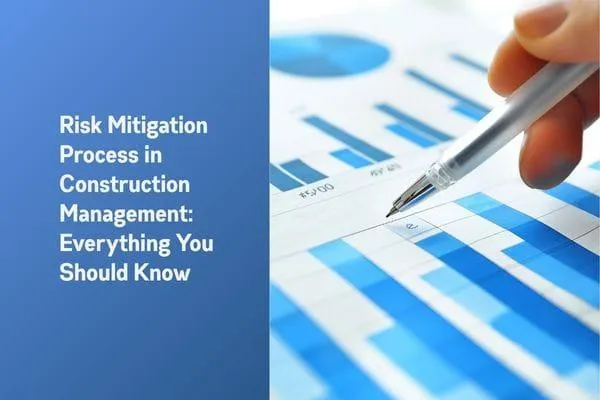
What You Must Know About The Risk Mitigation Process In Construction Management
When you hear about big construction projects going off track, it usually means something went wrong in the risk mitigation process in construction management. It’s that behind-the-scenes system that keeps everything from falling apart when things don’t go as planned.
The truth is, every construction project faces risk. Some see it coming, others don’t. But those who know how to manage it smartly are the ones who finish strong.
In this article, I’ll break down the risk mitigation process in construction management, show why it’s critical, and walk you through practical steps to keep your projects on track.
What You Must Know About the Risk Mitigation Process in Construction Management
What is the Risk Mitigation Process in Construction Management?
Why You Can’t Skip Risk Mitigation in Construction Projects
What Are the Different Categories of Risk in Construction?
5 Steps in the Construction Risk Mitigation Process
Step 1: Identify the Risks Early
Step 5: Monitor, Review, and Adjust Continuously
Tailoring the Process: Making It Fit Your Project
Sample Risk Mitigation Plan for a Mid-Sized Project
What is the Risk Mitigation Process in Construction Management?
When you hear the risk mitigation process in construction management, consider it as your project’s safety net, the system that keeps things under control when challenges appear.
It’s a sequence of smart moves made before and during construction to reduce how often problems or delays occur, and if they do happen, make them less harmful.
Here’s how it fits into the bigger picture. In construction risk management, you first spot risks, then you analyze them, pick responses, carry out mitigation, and keep checking back. Mitigation is just one part, but it’s a heavy lifter.
The key is not trying to eliminate every risk, that’s impossible. Instead, you reduce them, share or transfer them (like via insurance or contracts), or accept minor ones if their fallout is small.
What matters is that your mitigation plan matches your project’s reality – soil types, local rules, supply chain quirks, team skill levels, and weather patterns.
Why You Can’t Skip Risk Mitigation in Construction Projects

We hear stories – “90% of projects run over budget,” or “99 % of big projects face delays.” Those aren’t exaggerations. According to McKinsey, over 500 large capital projects averaged cost overruns of 79% and schedule delays by 52%.
Also, multiple sources say that nearly 98% of construction projects exceed their budgets or are delayed. That means almost every project faces trouble, so mitigation isn’t optional.
Why else does risk mitigation truly matter:
Money is tight: Even a small delay or error can drain profits.
One issue triggers another: If plumbing isn’t ready, finishing work gets pushed back, and workers end up waiting.
Reputation matters: A failed build can haunt your next bid.
Legal exposure: Contracts, penalties, claims, and the legal costs can be huge.
Unknowns are many: Unstable soil, bad weather, material shortages, or permit delays can all throw plans off track.
Remember that if you treat risk mitigation as a side task, you’ll be reacting to fires instead of preventing them.
What Are the Different Categories of Risk in Construction?
Before you fix or soften risks, you must see what kinds exist. Here are common categories of risk in construction (and why they matter):
Financial/Cost risk: Rising material prices, late payments, budget misestimation.
Schedule/Time risk: Rain, permit delays, late deliveries, subcontractor slipping.
Technical/Design risk: Mistakes in drawings, missing details, conflicts among disciplines.
Contractual/Legal risk: Ambiguous clauses, variation orders, claims, penalties.
Operational/Execution risk: Equipment breakdown, weak supervision, and site logistics problems.
Environmental/Site conditions: Bad soil, hidden utilities, flooding, contamination.
Health & Safety risk: Injuries, safety standard violations, and site accidents.
Classifying helps as you see which buckets are “hot zones” for this particular project. Some projects suffer mostly from soil risk, others from permitting or scope safety risks. When you know your categories, you can avoid blind spots.
5 Steps in the Construction Risk Mitigation Process
Risk mitigation in construction doesn't mean avoiding mistakes, it means staying ready for them. Every project, whether it’s building a bridge or a small home, carries its fair share of surprises.
The following five steps help project managers predict, prepare, and prevent problems before they turn into disasters.

Step 1: Identify the Risks Early
The first step is simple, but it's important. Identify the risks before they spot you. At this stage, project managers list everything that could go wrong, from design errors and material shortages to weather delays or labor strikes.
According to McKinsey & Company, large construction projects typically take 20% longer to finish and run up to 80% over budget. That’s not only bad luck, that’s often poor risk identification. You heard that right.
So, during planning, every small doubt or “what if” question is written down. By identifying risks early, the team can turn potential disasters into manageable tasks.
Step 2: Assess and Prioritize
Once risks are identified, it’s time to judge how serious they are.
Not every risk deserves the same attention. For instance, a short delivery delay might hurt your schedule a little, but a labor shortage could freeze the whole project. That’s why construction managers often use a 5x5 risk matrix, rating each risk by its likelihood and impact.
This helps rank risks as low, medium, or high. The most dangerous and most likely ones get top priority. This step builds clarity, and you can see what really needs attention first.
Step 3: Create an Action Plan
Here comes the heart of the process – developing a risk mitigation plan. This doesn’t mean blocking every risk, it means staying ready. For example, if weather delays are common, include buffer days in your timeline. If material prices fluctuate, sign flexible contracts.
According to KPMG’s Global Construction Survey 2023, many firms are now shifting focus toward resilient planning rather than reactionary measures.
That means lesser last-minute fixes, more calm, and steady progress. In simple words, plan like the rain is coming, even if the sky looks clear.
Step 4: Take Action
Here is where the talk turns into work. Teams usually follow one of three paths:
Reduce the risk (by adding safety checks or better supervision)
Transfer it (through insurance or subcontracting)
Accept it (when the risk is minor or unavoidable)
The trick is to stay flexible. No two projects face the same mix of risks. For instance, a bridge project might need high insurance coverage, while a small home build might rely on careful scheduling instead.
Consistency here makes all the difference. Projects that stay on track tend to be those where teams act early instead of reacting late.
Step 5: Monitor, Review, and Adjust Continuously
You can’t set your risk plan and forget it; risks shift as the project moves along. So this step is all about staying alert and adaptive. Walk the site, talk with your team, and revisit your risk list regularly.
Use tools or simple logs to capture when risks materialize or when new ones pop up. Every time you adjust tasks, re-evaluate likelihoods and impacts. If mitigation isn’t working, tweak it.
At project end, hold a review: record what worked well, what surprised you, and what you would do differently next time. That’s how strong teams stay ahead, by turning experience into better planning for the next build.
Tailoring the Process: Making It Fit Your Project
Not all construction projects are the same, so the risk mitigation process shouldn’t be one-size-fits-all. Large infrastructure projects may require detailed modeling and simulation, while a small residential building can succeed with a simpler, practical checklist.
Contract type also matters. Design-build projects shift some risk from the client to the contractor, while traditional design-bid-build keeps more responsibility with the client.
Your local environment, weather patterns, and supply chain conditions should influence your mitigation plan. Finally, think about your team’s strengths, use tools and techniques they can manage effectively.
Tailoring the process means it works, instead of being another document gathering dust.
Sample Risk Mitigation Plan for a Mid-Sized Project
This table is just a starting point. The real value comes when you track, adjust, and integrate it into daily workflows.
Advanced Techniques & Tools for Risk Mitigation Process
Today, construction teams can go beyond simple checklists. Some advanced methods include the following.

Quantitative Analysis: Tools like Monte Carlo simulations help estimate the probability of cost overruns or delays.
Digital Dashboards: Track real-time metrics on risk likelihood, impact, and mitigation effectiveness.
Building Information Modeling (BIM): Detects design clashes before construction begins.
Scenario Planning: Teams simulate “what if” events to test the strength of mitigation plans.
These tools don’t replace judgment, but they make it smarter. Combining human insight with data-driven approaches ensures your risk mitigation process in construction management is precise and practical.
Final Word from Purely Startup
The risk mitigation process in construction management is the backbone of every successful project. Challenges like weather delays, design changes, or supply shortages are inevitable, but how you prepare determines your outcome.
By spotting risks early, prioritizing them, creating practical action plans, and continuously monitoring progress, you can prevent small issues from turning into major setbacks.
Don't think mitigation is about eliminating every risk, it’s about managing them smartly, tailoring strategies to your project’s reality, and keeping your team ready. Teams that adopt this mindset not only survive challenges but also finish strong, build trust, and save money.


